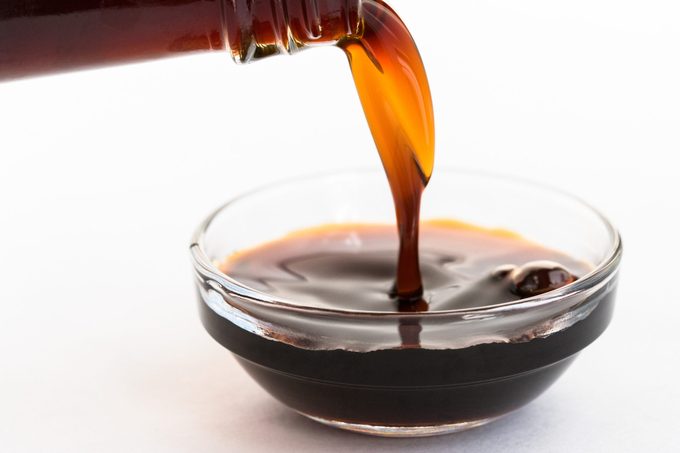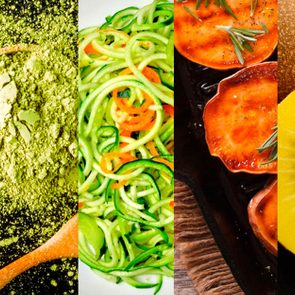Is Coconut Aminos Healthier Than Soy Sauce?
Updated: Feb. 12, 2021
Registered dietitian and plant-based diet specialist Cynthia Sass shares why coconut aminos is a popular soy sauce alternative.
Our editors and experts handpick every product we feature. We may earn a commission from your purchases.
The rise of coconut aminos
If you follow healthy recipe accounts online, you’ve probably noticed one trendy ingredient pop up often—coconut aminos. This liquid ingredient is often used as a substitute for soy sauce—popular in Asian cuisine, specifically Chinese and Japanese. Coconut aminos shares similar culinary properties with its traditional counterpart, but it’s quite different in its composition.
Here’s a look at what coconut aminos is made from, and some of the reasons why it’s become so standard, particularly in health-focused cooking. Plus, find out if it’s actually healthier than soy sauce. (For a healthy twist on your favorite sauces, try these healthier condiments.)
What is coconut aminos?
Coconut aminos is a brown liquid that can sometimes be made of fermented coconut palm sap that’s mildly salty and sweet in flavor. The ingredients in Bragg’s ($13 per 10-ounce bottle) brand of coconut liquid aminos are simply organic coconut blossom nectar, distilled water, organic apple cider vinegar, and sea salt. Coconut blossom nectar is the sap from the flowers of the coconut tree.
In addition to its natural sweetness, the sap contains minerals, including magnesium, potassium, zinc, and iron, as well as antioxidants, according to a 2020 study, published in the journal Food Science & Nutrition.
Coconut aminos and apple cider vinegar
Like Bragg’s version, coconut aminos that contain apple cider vinegar can deliver benefits from the vinegar itself. Apple cider vinegar is an age-old ingredient with published research to back many of its health claims, particularly for improving blood sugar regulation. One older study, published in Diabetes Care, was conducted in men and women with type 2 diabetes. Researchers found that compared to water, consuming apple cider vinegar before bed with the same snack (one ounce of cheese), led to lower blood sugar levels the following morning.
(Here’s what you need to know about taking apple cider vinegar shots.)
Another study in the same journal assessed people with diabetes, as well as healthy adults, and those with pre-diabetic insulin resistance. When less than one ounce of apple cider vinegar was consumed with a high-carb meal (a bagel and orange juice), all three groups experienced better blood glucose outcomes compared to a placebo. In those with pre-diabetes, blood sugar values were nearly 50 percent lower, and they dropped by about 25 percent in those with diabetes.
(These are the apple cider vinegar mistakes to avoid.)

Coconut aminos nutrition
Sodium is one factor that sets coconut aminos apart from soy sauce. Soy sauce has nearly double the amount, at 260 mg of sodium per teaspoon, or 11 percent of the advised daily cap. That difference can add up with regular use, or if a dish calls for a tablespoon rather than a teaspoon, which is three times the portion. (Here are the high-sodium foods to avoid.)
Here’s some nutritional information for one teaspoon of Bragg’s organic coconut aminos:
Calories: 10
Cholesterol: 0 g
Sodium: 140 mg (6 percent DV)
Carbohydrates: 2 g (1 percent DV)
Total sugars: 2 g (4 percent DV)
Coconut aminos vs soy sauce: Which is healthier?
Apart from the sodium difference, many people choose coconut aminos for another key reason. Soy sauce contains two common allergens—wheat gluten and soy. These components of soy sauce are among the “Big 8” most common allergens, identified by the U.S. Food and Drug Administration, which also includes peanuts, milk, shellfish, tree nuts, eggs, and fish.
A 2019 report from the International Food Information Council finds that one in six consumers report having a food allergy in the household. This is likely why foods that don’t contain common allergens have become increasingly in demand among shoppers. According to a 2019 report by consumer research group Mintel, the market for “free-from” foods, which omit top allergens, as well as ingredients like high fructose corn syrup and preservatives, is growing, and unlikely to slow in the near future.
A Mintel 2019 report found that 62 percent of consumers avoid at least one ingredient when selecting food products. The lack of common allergens in coconut aminos, and its simple, all-natural makeup, have fueled its popularity. (Also, try these plant-based swaps to replace dairy and meat.)
How to use coconut aminos
While coconut aminos is a bit sweeter and less salty compared to soy sauce, both ingredients provide umami flavor, the unique savory fifth taste. For this reason, coconut aminos works well in dishes like stir-fry, teriyaki, and marinades. You can swap soy sauce for coconut aminos in a 1:1 ratio in most recipes.
Store it in the fridge after opening, and use it as a condiment to sprinkle onto just about anything, from vegan sushi to cooked veggies or brown rice. (Here are some of the best vegan protein sources.)
The last word
Coconut aminos is a great soy-and gluten-free alternative that contains less sodium than soy sauce. It’s also wheat-free. It’s not necessarily a health food and it does add sodium to your diet, so it’s important to monitor your intake.
Be mindful that coconut aminos can be difficult to find at your local supermarket and it could be more expensive than soy. Overall, it’s a popular soy alternative that can be part of your low-sodium diet if used sparingly.























